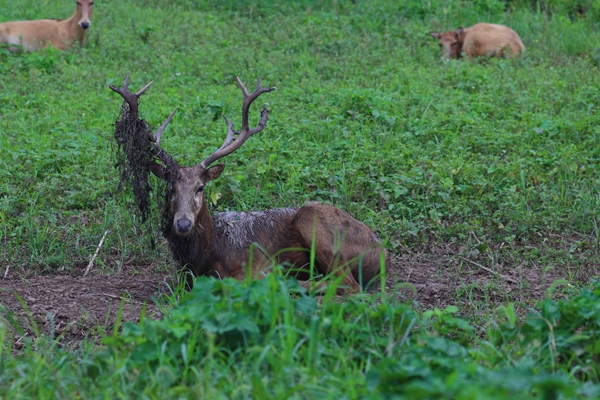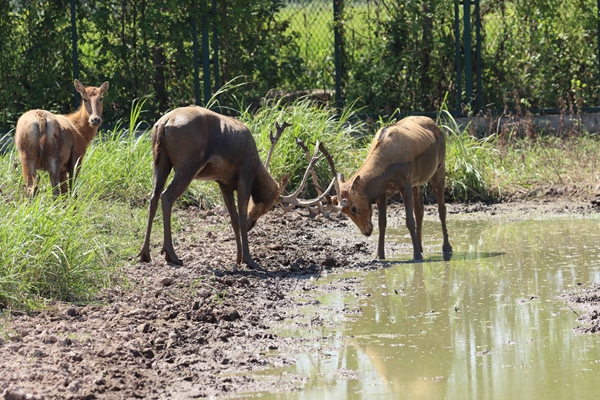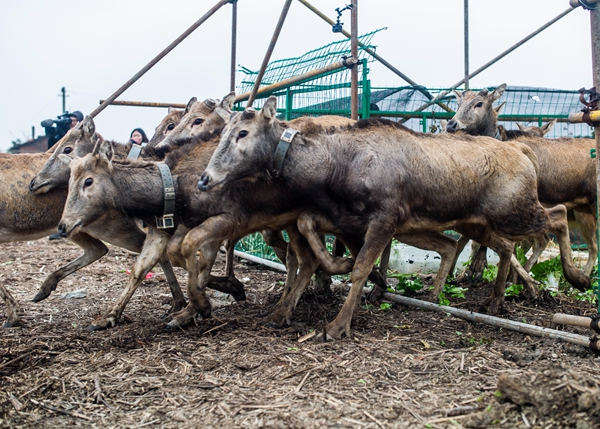Survival of a species

A milu alpha during the breeding season often wallows in mud to attract females.[Photo provided to China Daily]
The reintroduction of the milu deer to its motherland has seen the population bounce back from the brink of extinction, Shen Wendi reports.
A small herd of milu deer-six males and four females-paces back and forth uneasily at the entrance of a shelter in Nanhaizi Milu Park, located in Daxing district, beyond the South Fifth Ring Road of Beijing.
After a few minutes hesitation, the leading milu, puffing in trepidation, finally steps out and leads the rest of the deer along a wire-fenced passageway set up by researchers at the Beijing Milu Ecological Research Center that leads to a truck.
On Dec 7, the vehicle took them to East Dongting Lake National Nature Reserve in Central China's Hunan province, which is to be their new home. They were relocated to enrich the gene pool of the milu herd in the nature reserve.
Also known as Pere David's deer, milu are native to China, where they roamed on the marshes and plains along the Yellow River and the Yangtze River. But due to hunting and the loss of their natural habitat, their population dwindled to around 200 during the Qing Dynasty (1644-1911), when the last of the species could be found at Nanhaizi, which was then the royal hunting park.
The deer, which combine the features of a horse's face, a donkey's tail, a cow's hooves and a stag's antlers, were viewed as auspicious in Chinese mythology, but fortune did not smile on the milu and the species died out in the country in the early 1900s.

A fight between two male milu over the right to mate.[Photo provided to China Daily]
Fortunately, a French missionary named Pere David introduced the deer to France in 1866. Later, a few more milu were transported to other European countries.
The scattered migrants, however, didn't fare well in Europe, until Britain's Duke Herbrand Russell managed to gather 18 milu together at Woburn Abbey in 1898. Finally, they found a sanctuary.
Beijing Milu Ecological Research Center was founded in 1985 with the aim of reintroducing milu to China. From 1985 to 1987, joint efforts brought 38 milu back to Nanhaizi Milu Park.
In 1986, Milu Natural Reserve in Dafeng, Jiangsu province, was founded, bringing another 39 milu from England. Together, these 77 milu laid the foundation for the restoration of the species in China.
As the number of milu in China increased, more nature reserves were established in areas that they were known to once inhabit. Today, they can be found in 81 areas throughout China, as over the 35 years since the milu's return, their number has grown to more than 8,000.
Notably, they have formed wild groups independent of the protection of human beings.

Ten milu from Beijing arrive in Hunan province after being relocated to the East Dongting Lake National Nature Reserve on Dec 7.[Photo provided to China Daily]
When massive floods in 1998 destroyed the fences in Shishou Nature Reserve, north of Yangtze River, over 30 milu bravely swam across the river. They found a new home near East Dongting Lake where they formed what became the first wild herd of milu.
As a species adapts to a new environment, they will gradually develop certain genetic features, keeping the useful traits and eliminating the bad ones. If members of the same species from different locations interbreed, it enriches their genetic diversity and reduces the possibility of disease.
Which is why the milu from Nanhaizi are being transported to East Dongting Lake, says Bai Jiade, director of the Beijing Milu Ecological Research Center.
The center has sent 546 milu to 41 nature reserves across the country since 1989.
"There are more than 8,000 milu in China now. To have milu from Beijing integrate into the wild groups in other places is an important way to help protect the species," Bai says.
The 10 milu that were transported to East Dongting Lake this time consists of both young and elderly deer. In the summers to come, they will compete for leadership and mates.
They have no idea of the plan laid out for them. The 30-hour trip has just made them sullen and tired.
As the truck drives into the reserve, they perk up after smelling the marsh.
What awaits them is a broad field of 190 hectares with abundant water, grasses and sedges, over 200 bird and plant species, and others of their kind.
Getting off the truck, they take a short break in a shelter. The moment the fences open, they bounce out and into a trot, vanishing into the reeds. But this is not the end of their story.
Soon they will be put to the test. A waterproof GPS collar is attached to each of them, which will enable the researchers to observe their habits after being released.
In the upcoming decades, researchers will further analyze the behavior and evolution of the species with genetic tools, and their influence on the ecosystem as a flagship wetland species.
"The revival of milu in China has set a good example for species reintroduction. Our ultimate goal is to enable them to survive on their own. After all, they belong to nature," says Yang Sheng, director of the reserve.

